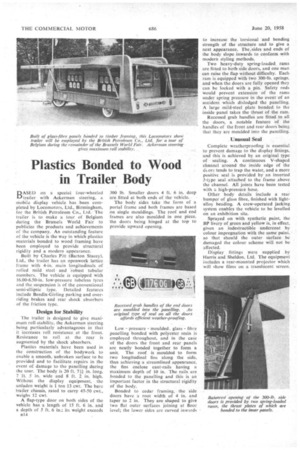Plastics Bonded to Wood in Trailer Body
Page 48

If you've noticed an error in this article please click here to report it so we can fix it.
BASED on a special four-wheeled trailer with Ackerman steering, a mobile display vehicle has been completed by Locomotors, Ltd., Birmingham, for the British Petroleum Co., Ltd. The trailer is to make a tour of Belgium during the Brussels World Fair to publicize the products and achievements of the company. An outstanding feature of the vehicle is the way in which plastics materials bonded to wood framing have been employed to provide structural rigidity and a modern appearance.
Built by Charles Pitt (Barton Stacey), Ltd., the trailer has an openwork lattice frame with 4-in, main longitudinals of rolled mild steel and robust tubular members. The vehicle is equipped with 16.00-6.50-in, low-pressure tubeless tyres and the suspension is of the conventional semi-elliptic type. Detailed features include Bendix-Girling parking and overriding brakes and rear shock absorbers of the friction type.
Design for Stability
The trailer is designed to give maximum roll stability, the Ackerman steering being particularly advantageous in that it increases roll resistance at the front. Resistance to roll at the rear is augmented by the shock absorbers..
Plastics materials have been used in the construction of the bodywork to enable a smooth, unbroken surface to be provided and to facilitate repairs in the event of damage to the panelling during the tour. The body is 20 ft. 74-1 in. long. 7 ft. 5 in. wide and 8 ft. 2 in. high. Without the display equipment, the unladen weight is 1 ton 13 cwt. The bare trailer ,chassis, rated to carry 45-50 cwt., weighs 12 cwt.
A flap-type door on both sides of the vehicle has a length of 15 ft. 6 in. and a depth of 5 ft. 6 in.; its weight exceeds
B 1 4
300 lb. Smaller doors 4 ft. 6 in. deep are fitted at both ends of the vehicle.
The body sides take the form of a portal frame and both frames are based on single mouldings. The roof and end frames arc also moulded in one piece, the doors being hinged at the top to provide upward opening.
Low pressure moulded. glass fibre panelling bonded with polyester resin is employed throughout, and in the case of the doors the front and rear panels are neatly bonded together to form a unit. The roof is moulded to form two longitudinal fins along the side, thus achieving.a streamlined appearance, the fins enclose cant-rails having a maximum depth of 10 in. The rails are bonded to the panelling and this is an important factor in the structural rigidity of the body.
Bonded to cedar framing, the side doors have a root width of 4 in, and taper to 2 in. They are shaped to give two flat outer surfaces joining at floor level; the lower sides arc curved inwards to increase the torsional and bending strength of the structure and to give a neat appearance. The,sides and ends of the body slope inwards to conform with modern styling methods.
Two heavy-duty spring-loaded, rams are fitted to both side doors, and one man can raise the flap without difficulty. Each ram is equipped with two 300-lb. springs, and when the doors are fully opened they can be locked with a pin. Safety rods would prevent extension of the rams under spring pressure in the event of an accident which dislodged the panelling. A large mild-steel plate bonded to the inside panel takes the thrust of the ram.
Recessed grab handles are fitted to all the doors, a notable feature of the handles of the front and rear door's being that they are moulded into the panelling.
. Unusual Seal
Complete weatherproofing is essential to prevent damage to the display fittings, arid this is achieved by an original type of sealing. A continuous V-shaped channel around the inside edge of the et.ors tends to trap the water, and a more positive seal is provided by an inverted .1-1.)pe seal attached to the frame above the channel. All joints have been tested with a high-pressure hose.
Other body details include a rear bumper of glass fibre, finished with lightalloy beading. A crew-operated jacking system enables the vehicle to be levelled on an exhibition site.
Sprayed on with synthetic paint, the BP livery of green and yellow is, in effect, given an indestructible undercoat by colour impregnation with the same paint, • so that should the outer surface be damaged the colour scheme will not he affected.
Display fittings were supplied by 1-farris and Sheldon, Ltd. The equipment includes a rear-mounted projector which will show films on a translucent screen.




































































































